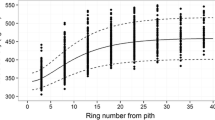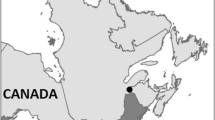Abstract
Density is a fundamental softwood quality trait. The aim of this paper is to identify a spatial model for wood density variation in spruce stems, with the main focus on basic density. Six thousand 20-mm-wide cubes systematically sampled from 85 trees in western Norway were analysed. The overall radial density pattern was the J shape with local maximum in the pith and increasing density outwards from a minimum at some distance from the pith. The minimum appeared closer to the pith further up in the tree. The stochastic nature of the six tree-wise parameters defining density gradients from pith to surface and from base to top was analysed and described. The results provide information needed to simulate density variation inside stems and between stems in a population. Considering the fundamental influence of density on a range of wood traits, such simulation should be of great significance for scientific and industrial analyses.




Similar content being viewed by others
References
Danborg F (1994) Density variation and demarcation of the juvenile wood in Norway spruce. Dan For Landsc Res Inst Forskningsserien 10:1–78
Gardiner B, Leban J-M, Auty D, Simpson H (2011) Models for predicting wood density of British-grown Sitka spruce. Forestry 84:119–132
Jyske T, Mäkinen H, Saranpää P (2008) Wood density within Norway spruce stems. Silva Fennica 42:439–455
Klem GG (1934) Investigations on the quality of spruce wood (In Norwegian). Meddelelser fra Det Norske Skogforsøksvesen nr 17, Ås, p 348
Knigge W, Schulz H (1966) Grundriss der Forstbenutzung. Verlag Paul Parey, Hamburg, p 584
Kollmann FFP, Cöté WA (1968) Principles of Wood Science and Technology. Reprint 1995 by Pensumtjeneste, Oslo, p 592. ISBN: 82-13-00284-9
Lohmann U (1993) Holz Handbuch. DRW-Verlag, Leinfelden-Echterdingen, p 312. ISBN: 3-87181-322-2
Molteberg D, Høibø O (2007) Modelling of wood density and fibre dimensions in mature Norway spruce. Can J For Res 37:1373–1389
Olesen PO (1973) The influence of the compass direction on the basic density of Norway spruce (Picea abies L.) and its importance for sampling for estimating the genetic value of plus trees. Forest tree improvement, Copenhagen, p 58. ISBN: 87-500-1343-2
Olesen PO (1977) The variation of the basic density level and tracheid width within the juvenile and mature wood of Norway spruce. Forest tree improvement, Copenhagen, p 21. ISBN: 87-500-1780-2
Øvrum A (2013) In forest assessment of timber stiffness in Norway spruce (Picea abies (L.) Karst.). Eur J Wood Prod 71(4):429–435
Repola J (2006) Models for vertical wood density of scots pine, Norway spruce and birch stems, and their application to determine average wood density. Silva Fennica 40:673–685
Shmulsky R, Jones PD (2011) Forest products and wood science: an introduction. Wiley-Blackwell, Sussex, p 477. ISBN: 13: 978-0-8138-2074-3
Sonderegger W, Mandallaz D, Niemz P (2008) An investigation of the influence of selected factors on the properties of spruce wood. Wood Sci Technol 42:281–298
Statsoft (2012) Statistica, software for statistical analyses. www.statsoft.com. Accessed 22 Nov 2012
Stern K (1963) Einfluss der Höhe am Stamm auf die Verteilung der Raumdichte des Holzes in Fichtenbeständen. Holzforschung 17:6–12
Trendelenburg R, Mayer-Wegelin H (1955) Das Holz als Rohstoff. Carl Hanser Verlag, München, p 541
Tsoumis G (1991) Science and technology of wood: structure, properties, utilization. Chapman & Hall, New York, p 494. ISBN: 0-412-07851-1
Vestøl G, Høibø O, Langsethagen KG, Skaug E, Skyrud REA (2012) Variability of density and bending properties of Picea abies structural timber. Wood Mat Sci Eng 7:76–86
Volkert E (1941) Untersuchungen über Größe und Verteilung des Raumgewichts in Nadelholzstämmen. Schriftenreihe der Deutschen Forstwissenschaft, Frankfurt, p 133
Wilhelmsson L, Arlinger J, Spångberg K, Lundqvist S-O, Grahn T, Hedenberg Ö, Olsson L (2002) Models for predicting wood properties in stems of Picea abies and Pinus sylvestris in Sweden. Scand J For Res 17:330–350
Wood Handbook (2011) Wood as an engineering material. 2010 Edition, Forest Products Society, Madison. ISBN: 978-1-892529-59-6
Acknowledgments
This work was supported by The Research Council of Norway and by The Norwegian Forest and Landscape Institute. The authors wish to thank the forest owners for giving free access to all sampled trees, to the district forest officers in Hordaland and Sogn og Fjordane for invaluable assistance, to Torbjørn Okstad for organising the sampling and to all colleagues who helped in the field and in the laboratory, in particular Ivar Fæste, Bjørn Slette, Arnstein Orlund and Kari Hollung. The English text was revised by Nicholas Clarke.
Conflict of interest
The authors declare that they have no conflict of interest.
Author information
Authors and Affiliations
Corresponding author
Rights and permissions
About this article
Cite this article
Gjerdrum, P., Eikenes, B. A model for spatial wood density gradients in Norway spruce stems and stochastic between-stem dissimilarities for basic and dry density. Wood Sci Technol 48, 71–84 (2014). https://doi.org/10.1007/s00226-013-0586-z
Received:
Published:
Issue Date:
DOI: https://doi.org/10.1007/s00226-013-0586-z




